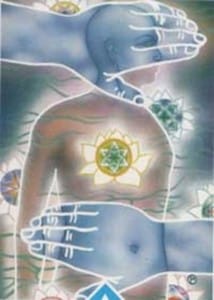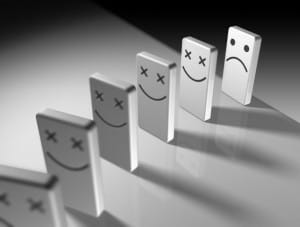
In times of serious illness, we tend to want to find effective approaches and methods that will lead us to a cure as quickly as possible. No matter how deep the process then goes – sometimes the choice and implementation of a method is already enough for a cure, other times a person has to go through a complete transformation of the self, with the method being only a tool for inner transformation – some people may decide and choose a method right away, while others embark on a journey of search.
I took a different path. It was in my nature that I could not finish things until I had all the answers. My mind was grinding and grinding until I got to the bottom of things. Only then could I let them go and move on.
In addition, I resisted change for a long time. I have been looking for ways to keep my existing habits (and the thinking, perceptions and feelings that go with them) or to continue living the old way.
So I needed an experience that literally threw me off track.
It was a difficult journey, but I had no choice.
On this journey of self-discovery through health, I soon found myself at an important turning point, which manifested itself in the form of two questions. By answering them, I had laid a foundation that was solid enough to carry the weight of all the decisions that followed.

The two questions that needed a clear answer were:
- what health is,
- how a disease or change in body tissue occurs .
The answer to the first question gave me a general view, which represented both a vision and an end goal. With the help of the second, I chose a path.
In other words, the first answer revealed a deeper insight into the situation I found myself in, re-evaluated the priority of life areas and decisions, and put the symptoms of the disease in the right light.
The second answer defined the process.
Immediately afterwards, a decisive turning point took place. I stopped looking for shortcuts or the “best method” to continue my existing lifestyle habits, and instead put the real priority first – the long-term health of my soul.
So I moved from struggling and resisting change to a constructive attitude towards change and acceptance of the new situation.
Without this step, which follows from the two questions mentioned above, I would most likely get lost in the search for an effective healing technique, in the sense of “Which technique should I choose? How much chance do I have that this technique will cure me?” You just ask yourself these questions as long as the main goal is to eliminate the symptoms.
The turnaround of the village

I began to wonder what all had to change deep within me to be fulfilled at the deepest level and to embrace Life in all its greatness. It was no longer a question of doing a technique, but of having a deep and genuine relationship with myself; with all those parts that I might not have known before, that I was ashamed of, turned a blind eye to, and so on.
Now I am beginning to wonder how I can accept them. Not in the sense of how I can understand them – that’s the ego’s game to maintain the status quo – but just to perceive them and let them express themselves as they wish. With all the support I can give them.
This step was a difficult one, as it required courage and an unwavering decision. It was a threat to the existing identity or idea of myself that I had been harbouring… and waving it in front of myself and others.
So let us answer the two questions that enable us to turn inwards.
Defining health through experience or end state
The first question – what is health anyway – is about our current state, but also about our aspirations and goals. When we set our priorities, we build up an image in our minds of what we want to achieve.
In this division, there are three levels that define health or health status. They differ according to our awareness or level of consciousness:
- Level 1: We seek perfect health, represented by a body free of disease symptoms.
- Level 1: We seek perfect health, but not just through a body free of disease symptoms, but also overall satisfaction.
- Degree: We are not looking for anything, but perceive the state of the body as a map that reveals our management of our own life energy.
Let’s take a closer look at the three stages.
At the basic, first level , we think of perfect health as a body free of symptoms, pain and other discomforts. We are primarily interested in physical health, which is supposed to be the basic foundation of our contentment. The saying that best describes this level of awareness is: “Just to be healthy!”
At the second level, health is perceived as a state of general satisfaction. So we are not only interested in the absence of symptoms on the body, but also in the “health” of the emotions, thoughts and spirit. We realise that a healthy body alone does not guarantee personal satisfaction, and we want harmony on all levels.
So our goal is still some optimal state that makes us feel good. Except that we have now extended it from the physical to the other levels.
At the highest level, we are no longer seeking optimal conditions or circumstances that make us happy, but rather we are usingan imperfect state of health to see what is happening to our life energy. Therefore, we do not try to correct this condition in the sense of eliminating the symptoms, but either accept it or, through it, discover the causes that have led to the end state.
We are no longer talking about perfect health, but about what the American healer and great esoteric expert Paul Solomon called perfect health.
At this stage, we also realise that the body is just one of the maps through which we receive messages about what is going on deep inside us. The other two maps are finances and relationships (with ourselves and with others).
Through these maps, we are confronted with the final consequence or result that we have created through conscious and unconscious expression. “The wallet never lies”, goes the famous saying. Neither does our body lie, nor do the relationships we have created. Everything is a mirror of our past choices, combined with the workings of unconscious processes.
When we realise this, we do not put more emphasis on the body, but treat all the areas through which we express ourselves with the same importance and care. In the same way, we treat our thoughts and emotions, which always precede our decisions, and lead to results.
We can also often find that our pattern of action is the same in all important areas. For example, if deep down we believe that we do not deserve the best, this belief may manifest itself as a hole in the wallet, as a symptom of illness or through broken relationships. It can also be in two or even all three areas at the same time.
Effects or influences on the body: cause or trigger?

The second division – answering the question of how a disease or change in body tissue occurs – will be based on the effects on the body.
The advantage of this view is that it defines processes that make it easier to identify the causes of disease and, consequently, to find solutions.
Because if we can truly capture all the possible causes and separate them from the triggers, we also have a roadmap to a solution.
Let’s take a small step back and look at the difference between causes and triggers, as these two terms are often not distinguished or used synonymously.
The cause is the primary condition that determines whether or not a realisation – for example, a disease – will occur.It is most often hidden at a deeper (higher) level than the physical, although it ultimately expresses itself as a change in the tissue.
On the other hand, we have the trigger. This is the activity that triggers the reaction through which change occurs. For example, certain foods, pollens and the like can be a trigger for a change in a physical condition; we say it is an allergy. The cause, however, lies deep within the body, which perceives such “invaders” in a specific way.
The link between causes and triggers is as follows: triggers help the cause to express itself or to be realised. There can be many triggers, all leading to the same goal. If there is no causal situation, triggers will not lead to significant change.
For example, if you light a match in a normal room, it will not trigger any reaction. If there is a gas leak in the room, it will. So the match was the trigger and the gas in the air was the cause.
Once a causal situation is established, different triggers can lead to the same consequence. In the case of an explosion, for example, a spark from a lighter, a discarded cigarette, etc. could be a trigger in addition to a match.
In any case, we need both a cause and a trigger to perform an action.
But this division is not always so clear. Especially not when it comes to a change in health status. Often, we give the cause the role of cause – and therefore too much importance – and consequently (too much) concern about it.Meanwhile, we neglect the actual cause, which can flourish and gain strength …
The solution to avoid all these (unnecessary) definitions and searches is to answer the second question and to look atthe change in the body through action from different levels. It will cover practically all situations and there will be no more uncertainties as to whether we have got to the bottom of the matter or whether there is something more lurking beneath the surface.
This article is based on the book “The Big Ugly Crisis”, by Boris Vene and Nikola Grubiša.
